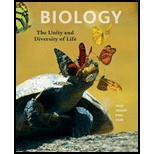
Concept explainers
In cladistics, the only taxon that is always correct as a clade is the _______.
- a. genus
- b. family
- c. species
- d. kingdom
Concept introduction: The taxon “species” is the basic unit of classification, and it is the unit of biodiversity. It comprises of organisms that resemble very close to each other. The term “clade” includes a group of organisms that are believed to comprise all the evolutionary descendants of a common ancestor.
Answer to Problem 1SQ
Correct answer: In cladistics, the only taxon that is always correct as a clade is the species. Therefore, option c. is the correct answer.
Explanation of Solution
Reason for the correct answer: Taxonomy is a biological practice of identifying different organisms, classifying them into different categories, and naming them. Organisms are classified according to their similarities and differences. Each hierarchy of taxonomy is known as taxa and species is the fundamental unit of this taxonomic classification. Cladogram is the pictorial representation of comparison of different groups of animals that are very closely-related with each other because of their shared ancestry. Therefore, both clade and species come under the same category, as the members come under them are much related to each other and also they share a common ancestry.
Option c. is given as “species”. The only taxon that is always the same as a clade is the species. Therefore, option c. is the correct answer.
Reason for the incorrect answers:
Option a. is given as “genus”. It is a taxonomic ranking used in biological classification. It comprises of several species, which are slighty different from each other. Hence, genus cannot be compared with a clade. Therefore, option a. is a wrong answer.
Option b. is given as “family”. In biological classification, it is one of the eight major taxonomic ranks, and it is divided into several subfamilies, which are intermediate ranks above the rank of a genus. As it is composed of several subdivisions, it does not have a group of members with the same characters as a clade. Therefore, option b. is a wrong answer.
Option d. is given as “kingdom”. It is a taxonomic category of the highest rank, grouping together all forms of life having certain fundamental characteristics in common. Hence, it cannot be compared with a clade. Therefore, option d. is a wrong answer.
Hence, options a., b., and d. are wrong answers.
Want to see more full solutions like this?
Chapter 18 Solutions
Biology: The Unity and Diversity of Life (MindTap Course List)
- When using the concept of "a calorie in is equal to a calorie out" how important is the quality of the calories?arrow_forwardWhat did the Cre-lox system used in the Kikuchi et al. 2010 heart regeneration experiment allow researchers to investigate? What was the purpose of the cmlc2 promoter? What is CreER and why was it used in this experiment? If constitutively active Cre was driven by the cmlc2 promoter, rather than an inducible CreER system, what color would you expect new cardiomyocytes in the regenerated area to be no matter what? Why?arrow_forwardWhat kind of organ size regulation is occurring when you graft multiple organs into a mouse and the graft weight stays the same?arrow_forward
- What is the concept "calories consumed must equal calories burned" in regrads to nutrition?arrow_forwardYou intend to insert patched dominant negative DNA into the left half of the neural tube of a chick. 1) Which side of the neural tube would you put the positive electrode to ensure that the DNA ends up on the left side? 2) What would be the internal (within the embryo) control for this experiment? 3) How can you be sure that the electroporation method itself is not impacting the embryo? 4) What would you do to ensure that the electroporation is working? How can you tell?arrow_forwardDescribe a method to document the diffusion path and gradient of Sonic Hedgehog through the chicken embryo. If modifying the protein, what is one thing you have to consider in regards to maintaining the protein’s function?arrow_forward
- The following table is from Kumar et. al. Highly Selective Dopamine D3 Receptor (DR) Antagonists and Partial Agonists Based on Eticlopride and the D3R Crystal Structure: New Leads for Opioid Dependence Treatment. J. Med Chem 2016.arrow_forwardThe following figure is from Caterina et al. The capsaicin receptor: a heat activated ion channel in the pain pathway. Nature, 1997. Black boxes indicate capsaicin, white circles indicate resinferatoxin. You are a chef in a fancy new science-themed restaurant. You have a recipe that calls for 1 teaspoon of resinferatoxin, but you feel uncomfortable serving foods with "toxins" in them. How much capsaicin could you substitute instead?arrow_forwardWhat protein is necessary for packaging acetylcholine into synaptic vesicles?arrow_forward
- 1. Match each vocabulary term to its best descriptor A. affinity B. efficacy C. inert D. mimic E. how drugs move through body F. how drugs bind Kd Bmax Agonist Antagonist Pharmacokinetics Pharmacodynamicsarrow_forward50 mg dose of a drug is given orally to a patient. The bioavailability of the drug is 0.2. What is the volume of distribution of the drug if the plasma concentration is 1 mg/L? Be sure to provide units.arrow_forwardDetermine Kd and Bmax from the following Scatchard plot. Make sure to include units.arrow_forward
 Concepts of BiologyBiologyISBN:9781938168116Author:Samantha Fowler, Rebecca Roush, James WisePublisher:OpenStax College
Concepts of BiologyBiologyISBN:9781938168116Author:Samantha Fowler, Rebecca Roush, James WisePublisher:OpenStax College Essentials Health Info Management Principles/Prac...Health & NutritionISBN:9780357191651Author:BowiePublisher:Cengage
Essentials Health Info Management Principles/Prac...Health & NutritionISBN:9780357191651Author:BowiePublisher:Cengage Human Biology (MindTap Course List)BiologyISBN:9781305112100Author:Cecie Starr, Beverly McMillanPublisher:Cengage Learning
Human Biology (MindTap Course List)BiologyISBN:9781305112100Author:Cecie Starr, Beverly McMillanPublisher:Cengage Learning Biology: The Dynamic Science (MindTap Course List)BiologyISBN:9781305389892Author:Peter J. Russell, Paul E. Hertz, Beverly McMillanPublisher:Cengage Learning
Biology: The Dynamic Science (MindTap Course List)BiologyISBN:9781305389892Author:Peter J. Russell, Paul E. Hertz, Beverly McMillanPublisher:Cengage Learning Biology (MindTap Course List)BiologyISBN:9781337392938Author:Eldra Solomon, Charles Martin, Diana W. Martin, Linda R. BergPublisher:Cengage Learning
Biology (MindTap Course List)BiologyISBN:9781337392938Author:Eldra Solomon, Charles Martin, Diana W. Martin, Linda R. BergPublisher:Cengage Learning





